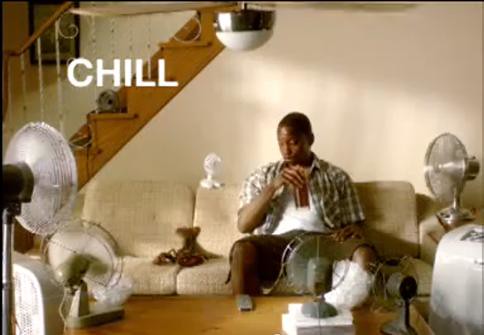Here in Washington, D.C., and probably where you live too, it is hot! This week’s Check Your Steps blog focuses on a timely food safety step—Chill. You may feel like this guy, but in reality we don’t recommend keeping your food cold with fans, no matter how many you can find.
Bacteria grow rapidly between 40 °F and 140 °F, and when it’s above 90 °F outside, cold food heats to those temperatures much faster. Portable coolers can be your best friend during outdoor summer activities or grocery shopping, but pack them correctly to keep food at 40 °F or below so it doesn’t spoil or make you sick.
You’ll need a cooler:

- If your grocery store is more than a half hour away from home
- When transporting food on roadtrips
- While boating, camping, or visiting the beach
- At cookouts
Make sure you have:
- Plenty of ice or frozen gel packs
- Preferably more than one insulated cooler
- An appliance thermometer
Keep these tips in mind:
- Pack perishable foods directly from the refrigerator or freezer into the cooler. Meat and poultry may be packed while still frozen—it will stay colder longer.
- A full cooler will maintain its cold temperatures longer than one that is partially filled. If the cooler isn’t completely filled, pack the remaining space with more ice.
- Keep raw meat, poultry, and seafood in a separate cooler or securely wrapped at the bottom of a cooler so their juices won’t contaminate already prepared foods or raw produce.
- Store food in watertight containers to prevent contact with melting ice water.
- Reserve one cooler just for beverages (which will be opened frequently), so that your food coolers will stay cold longer. Limit the times the food cooler is opened, and open and close the lid quickly.
- An appliance thermometer takes the guesswork out of knowing your food is safe to eat. Put one in your cooler, and make sure it reads 40 °F or below.
- When the temperature outside is above 90 °F, put perishable food back in the cooler within 1 hour after eating. Otherwise, cool it within 2 hours.
- For long trips, take along two coolers — one for the day's immediate food needs, like lunch or snacks, and the other for perishable foods to be used later in the vacation.
- At the beach, partially bury your cooler in the sand, cover it with blankets, and shade it with an umbrella for extra insulation.
FoodSafety.gov has more information on safe food storage temperatures. This concludes the Check Your Steps blog series, but you can follow #checksteps on Twitter for updates on the Food Safe Families campaign.
